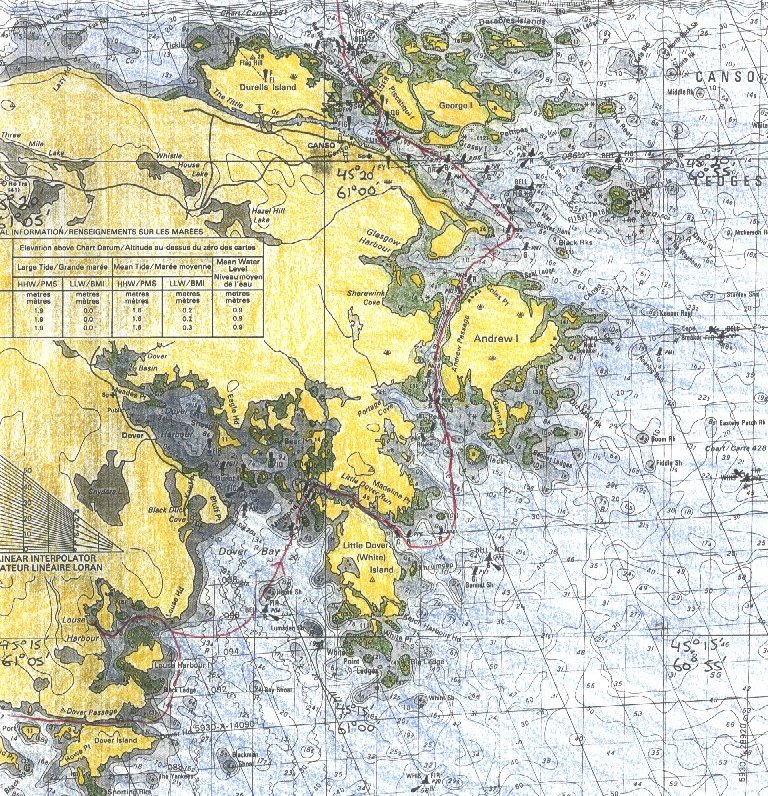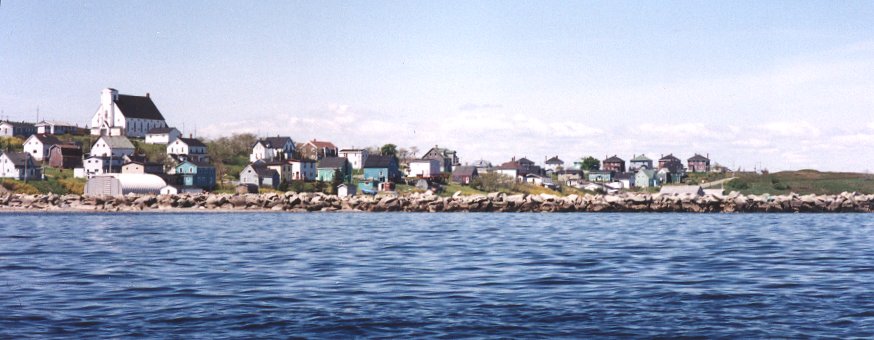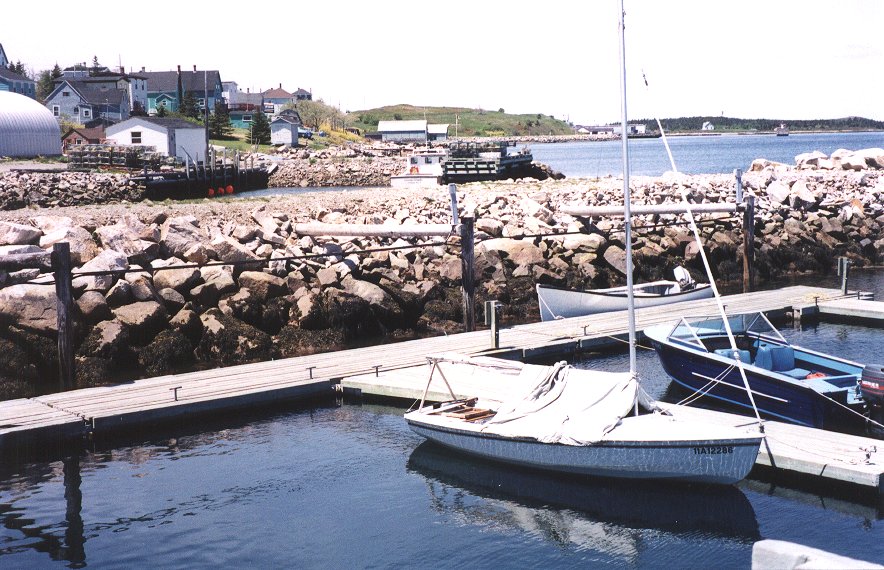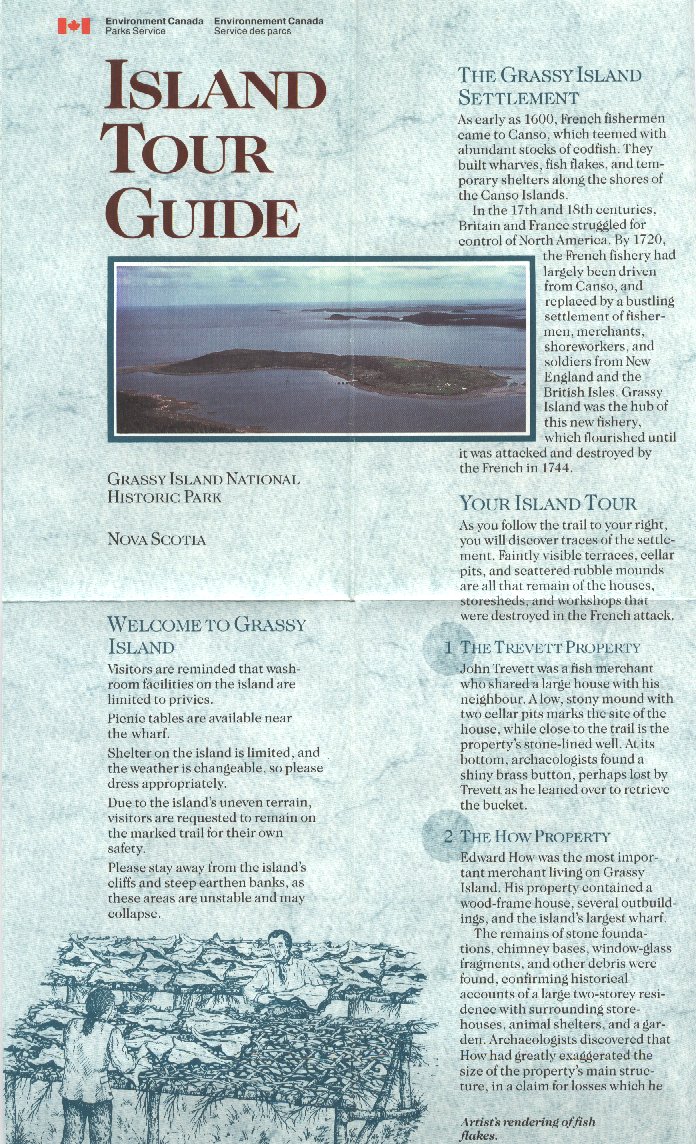| From the bell buoy, we headed for Little Dover Run; a
sheltered passage
behind Little Dover Island. The twisty opening to the Run is
indistinguishable
amongst the clutter of rocky outcrops and shoreline, so I steered a
compass
course for it. In the narrows of Little Dover Run, Naomi was
overtaken
by a weathered green trap skiff. The two men in drab oilskins asked,
“Where
you sailing from? Where’d you anchor last night? Where you sailing to
in
that little boat?” At their feet was a large galvanized pail from which
reddish brown lobster claws stretched to wave greetings. As our
conversation
ended, one of the fishermen reached into the pail, lifted one of the
creatures
out, and offered it to me as a gift. I refused the offer - with thanks
though.
Exiting Little Dover Run, I headed seaward to clear shoals off
Madeline
Point before sailing for Andrews Passage behind Andrews Island. This
section
of the coast has many shoals and I was thankful the weather was calm.
As
Naomi
cleared Andrews Passage, the wind died and left us drifting off Glasgow
Head. I was content to recline in the shade of the mainsail and wait
for
a breeze. On the horizon, Cranberry Island and its squat lighthouse
appeared
to hover above the water due to refraction.
My world was still except for a few lazy seagulls and
occasional fishing
boats coming and going from Canso. Eventually the breeze returned and
the
brightly painted wooden homes in Canso grew in size over the bow as we
sailed on.
|
| I decided to stay overnight at the marina primarily to get a
shower
but also it would be much quieter than the Fishermans Wharf which was
active
with lobster boats and crabbers. Besides Naomi, there were only
three small motorboats belonging to locals at the marina. The owner was
repairing the showers and they’d be ready by 1700 hours. In the
meantime
I walked into town called Gail: and stopped at the restaurant. While
waiting
for my meal, I glanced at the cheap reproduction of a painting over my
shoulder. I shuddered when I stared at it. Ships of the Spanish Armada
were foundering off the rockbound coast of Northern Ireland, leaving
survivors
clinging to broken spars as they waited to be dashed onto the rocks by
the rough sea. I have had similar visions of Naomi capsizing in
rough weather, me grasping onto her rigging while shivering with cold,
and being washed towards breakers on an identical shoreline.
On my way back to the marina, I stopped at the Grassy Island
Interpretive
Centre. The Federal Government operates a museum depicting the history
and living conditions on the island when it was an important fishing
station
and strategic position during the fourteenth to eighteenth centuries.
Being
the only visitor at the centre, I was surprised when the employees
offered
to take me over to Grassy Island on the converted Cape Island fishing
boat
and give me a guided tour of the island.
|
| While returning from Grassy Island, the skipper, the guide,
and I chatted
in the wheelhouse. A fishing boat with large circular crab pots passed
us on its way 30 miles or more out to sea. It began to lower long
stabilizing
arms from each side of the hull. On the end of these wings are small
torpedo-like
weights which are lowered into the sea. These complicated devices are
designed
to reduce the boat’s rolling. They are common on South Shore draggers
and
long liners which fish Georges Bank and the mouth of Fundy but rare on
Eastern Shore vessels. When I commented the boat must have originally
been
built down Shelburne way to be equipped with “sissy sticks”, the
skipper
laughed as it was his father’s vessel. He had never heard stabilizers
called
that before, and he’d be sure to kid his father about them on his
return.
It was only 1800 and I lounged under Naomi’s boom tent
at the
Canso marina. To celebrate my arrival in Canso, I indulged in a supper
of wine, cheese, and bread. Shortly before, I had luxuriated with a
long
steaming shower, and shaved at the marina washroom. Now I wore my
clean,
shore-going clothes, carefully bagged and stowed before the cruise for
just such an occasion. I really felt like “Jack in Port” after my
passage
from Port Dufferin. Although there didn’t appear to be much night life
in town, I would do a promenade anyway. I lay down for a brief nap
after
supper and fell asleep till 2200. Still groggy, I climbed into my
sleeping
bag without removing my shore duds and went back to sleep. So much for
my night on the town in Canso.
|




